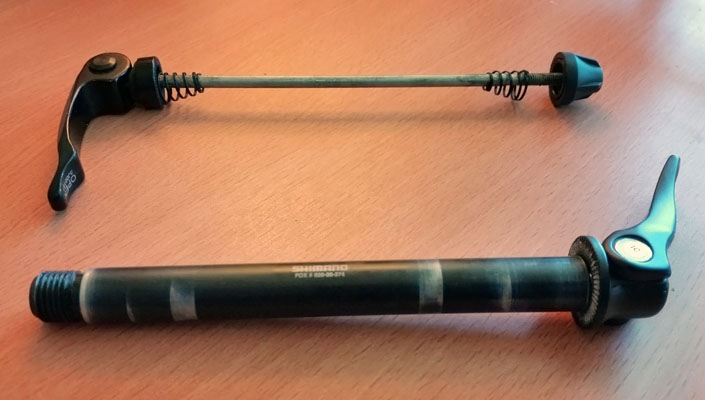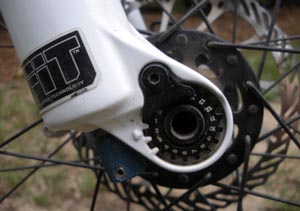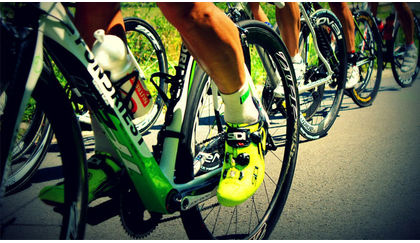
I am lucky enough to be in a two-cyclists relationship and even luckier to be in a "dating the mechanic" relationship. What does this mean? Well, often it means I get lots of new shiny things on my bike - not only without asking for them, but often without noticing them.
The latest on my Scott Scale MTB is a front wheel with a bolt through axle. Last week, the boy looks at me like an expectant puppy as I come to collect Scotty for a ride with the girls after having it serviced (by him, of course). He looks at me, then down at the bike. Then back at me, then back at the bike. Then back at me... you get the picture.
"Notice anything different?" he asks with wide, excited eyes.
"Ummmm..." is the normal response, mumbled as I frantically search the bike for something glaringly obvious. Like a whole new bright pink bike. I reckon I could spot that.
"I've given you a new front wheel and now you have a bolt through axle!"
"Brilliant! What does that do?"
Quick Release (QR) Axle
The axle, as we know, is the central shaft in the wheel. Currently, the most widely used axle on bicycles is the 9mm quick release - or QR skewer. You may recognize it from such activities as taking your front wheel off to put your bike in your car or locking the back wheel into a mag or fluid trainer. This popularity is changing, though, as more bikes are coming standard with wider thru axle designs.
As with anything else, for every pro there is a con. And in the case of the QR Axle, the pro is that it's quick to release (clue was in the title there), and that it is an industry standard design, but the cons are:

- Malfunction/misalignment due to incorrect (read: hasty) installation
- Smaller diameter so not as stiff
- Can loosen with rattling
- A number of little parts to lose under the cupboard or trailside
In mountain bikes with disc brakes, it has been identified that the forces generated by the disc brake can cause the skewer to loosen up during use. If you have ever ridden a mountain bike downhill at any speed, you will understand that this could constitute much more than an "uh oh" moment. Although cases like this are extremely rare, the forces from disc brakes can be better accommodated with a wider, sturdier axle/fork dropout than present with a standard quick release.
Thru Axle
In comparison to the QR Axle, a thru Axle is a shaft that is inserted through one side of the fork/frame, slides through the hub, and screws into the other side of the fork/frame. This undoubtedly leads to a stronger and more secure-fitting connection with no worries about the skewer loosening during your ride. Other pros include:

- It's all one piece so you can only lose the axle (but don't).
- Its wider and thicker diameter makes for a stiff wheel and steering 'tracking' , which means better deflection of bumps and better cornering.
- It has a natural 'lock' so you know when it's tight, which means less fussing and more riding
Also, because it slides straight through the hub and frame of the bike before locking, there is little room for error in "doing it up wrong".
Cons include cost associated with purchase and upgrade, there is not really an industry standard size, and it is a slightly heavier axle - perhaps up to 100g of extra weight... but this may just be weight you are happy to carry if you are a particularly gnar-core rider.
Options
Upgrading to a thru axle is going to be, in most cases, a poor cost vs. benefit equation. Unless your boyfriend is a bike mechanic with spares lying around, the cost of a hub conversion or wheel replacement, plus a new fork, would be prohibitively expensive when measuring up any perceived benefit.
Your best bet would be to check out the specifications on a new bike purchase. A thru axle fork is definitely the best way to go if within budget. It will result in better control because the drop outs afford much less flex when steering and braking, better wheel security, and greater overall strength.

RELATED ARTICLE:
5 Tips to make mountain biking more fun!
Next time your riding plans are thwarted, try not to stress; just accept the fact that you’ve missed out on your ride this time, get on with your day, and try to set aside five minutes to do this kick-ass bodyweight workout instead... READ MORE

RELATED ARTICLE:
5 minute drills to make you fast: Pedaling technique
Pedaling seems pretty simple, but when you break it down into its component phases it becomes evident that a good pedal stroke can save you energy and a poor one can waste power and effort... READ MORE


